Samsung Galaxy Note 10.1 (2014 Edition) Review
by Brian Klug & Anand Lal Shimpi on October 1, 2013 9:00 AM EST- Posted in
- Tablets
- Samsung
- Mobile
- Galaxy Note 10.1
GPU & Performance
Although Exynos 5420 fixes the big underlying issue with Samsung’s silicon on the CPU front, it’s actually the GPU that sees the most dramatic change. ARM once again wins Samsung’s GPU business and equipped the Exynos 5420 with a 6-core Mali-T628, replacing the PowerVR SGX544MP3 from the previous Exynos 5410. Overall performance takes a huge step forward. Looking at T-Rex HD (offscreen) we see the best example of where the Mali-T628MP6 lands: about 11% slower than Adreno 330 and 8% behind IMG’s PowerVR G6430 in the iPhone 5s. It’s definitely a competitive GPU with the latest and greatest from IMG and Qualcomm, but not faster than either. It’s incredible to think of just how far we’ve come. It wasn’t too long ago that we were complaining about non-Apple SoCs not taking GPU performance seriously, but here we are talking about competitive performance across the big three ARM vendors.
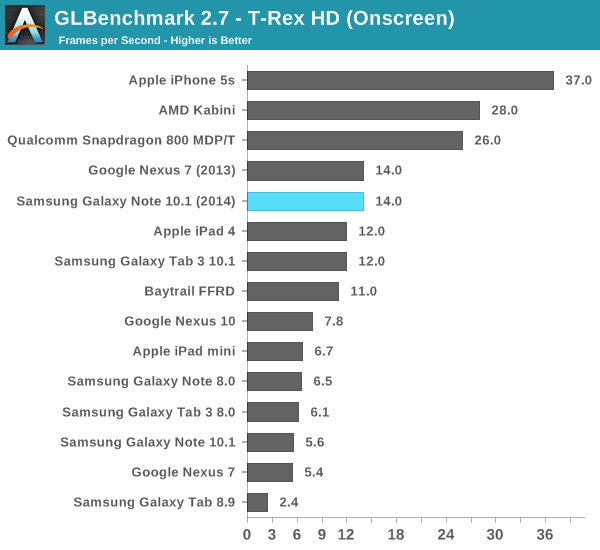
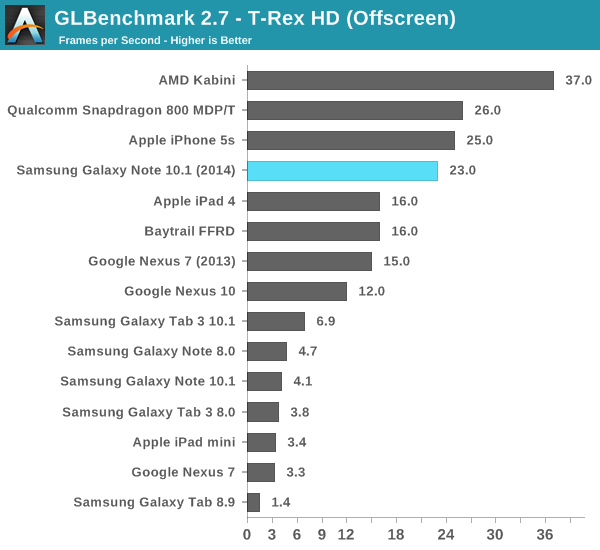
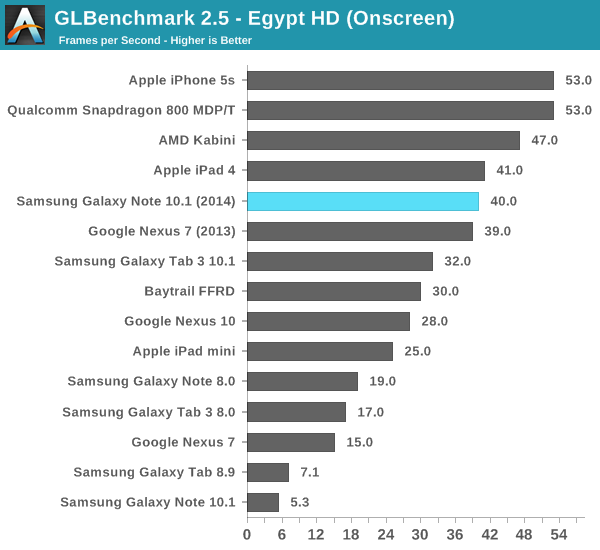
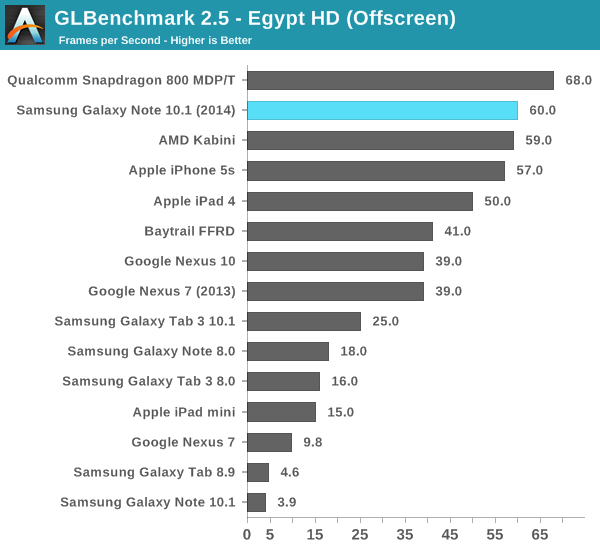
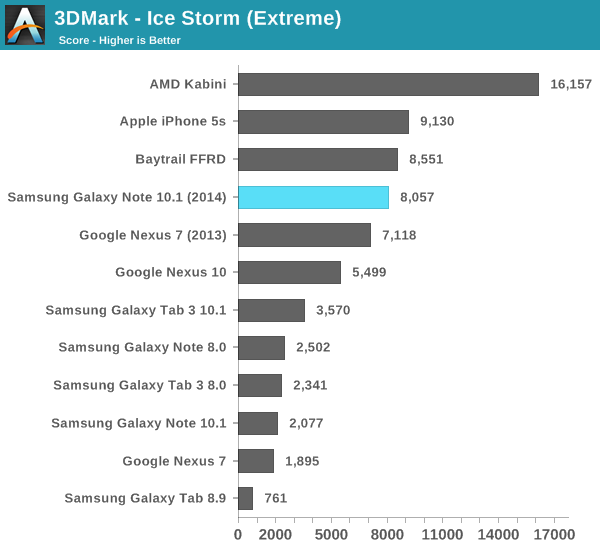


NAND Performance
We've been tracking storage performance on these devices for a little while now and have noticed forward progress over the generations. The new Note 10.1 does reasonably well in our IO tests, with its strengths being sequential read and random write performance (arguably the two more important metrics). Since the tablet ships with Android 4.3 it should feature FSTRIM support (something we're still verifying on the 2014 Edition), which will help keep NAND performance high as long as you don't fill up all of your storage (remember: try to keep ~20% of the internal NAND free at all times).
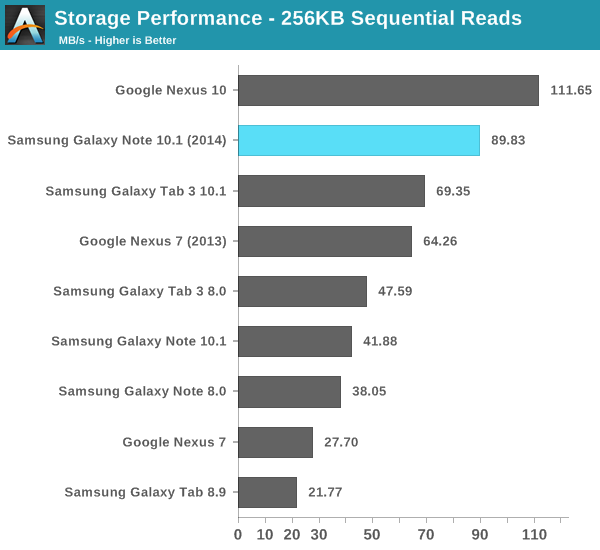

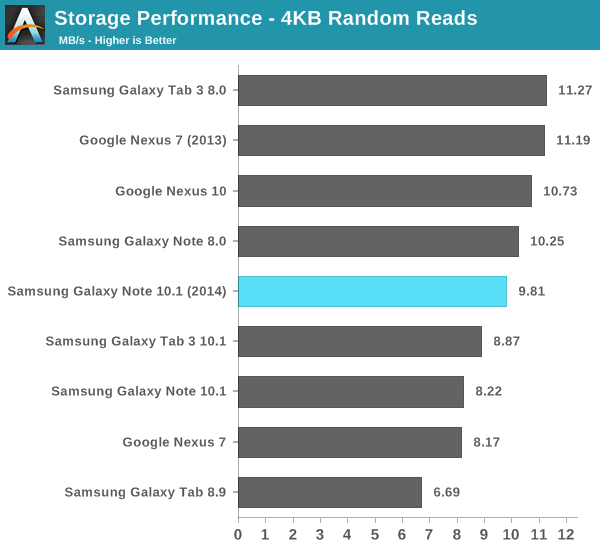











97 Comments
View All Comments
Diogenes5 - Tuesday, October 1, 2013 - link
So because of some arbitrary benchmark, you want to spend almost $400 dollars more on a device that will get even less support, has a worse resolution, and has even fewer dedicated apps?Ok fanboy, please leave the intelligent community at Anandtech alone and go back to the kiddie pool.
As always, Anandtech provides the best reviews. Looks like I'll be getting one write off the bat. As a student, I've been using last year's Note 10.1 as my daily driver along with LectureNotes and ezPDF. I could really use the upgrade in resolution and cpu/gpu in order to browse through my textbooks more quickly and precisely.
Da W - Tuesday, October 1, 2013 - link
"So because of some arbitrary benchmark, you want to spend almost $400 dollars more on a device that will get even less support, has a worse resolution, and has even fewer dedicated apps?"Looks like you are posting worst fanboy comments than me.
I just said the point that jumped in my face was how good the iPhone's 5s SoC was in the benchmarks, compared to a 10" tablet!
As for the other point, i used a tablet PC since 2000 something, and to that point the Surface Pro is the note-taking tablet perfected, WAY more useful for work or college work with a full office suite. I think MS has that niche covered better than Samsung. (price excluded, but a Baytrail surface pro would be perfect).
Impulses - Tuesday, October 1, 2013 - link
Bay Trail belongs on the regular Surface, and I imagine it'll show up as soon as they give up on RT... But other OEMs are soon gonna be seriously undercutting MS by offering Bay Trail on devices that are sold at the current price point of the original Tegra 3 Surface RT ($350, see ASUS), WITH keyboard dock even. Windows tablets would spread so much quicker if they'd just give up on RT already imo, and started pricing them appropriately (Pro's fine, but Surface's overpriced for what it is and what it's competing with).Da W - Tuesday, October 1, 2013 - link
RT is a long term plan to be platform agnostic. *IF* Windows 8.X sees enough success, *IF* enough developpers build Metro apps for it, *IF* office and other popular windows software are translated to Metro format and *IF* the convergence between widnows phone and windows 8 succeed, then in 2-3 years Microsoft will be free of intel and just pick whatever best SoC the market has to offer at that time. Which may or may not be Intel's.However, in order to do that, Microsoft had to push Windows RT to see widespread adoption, and they had to force Metro down a few peoples' troat in windows 8 desktop. In retrospect, may be they are failling, but they had no choice to do what they did in order to acheive their goal. Otherwise, if intel dies, they die. And yes when you look at the trend, ARM is picking up quickly and charging cheap.
Problem is: they have to improve Metro by a wide margin and open it up. Windows 8.1 is not nearly enough. Then developers need to adapt their software to it.
I'm surprised so few people picked that up.
Diogenes5 - Tuesday, October 1, 2013 - link
Baytrail runs Android just as well as Windows 8.1 if Intel marketing is to be believed. For platform agnostics, if a company can come out with a good baytrail tablet with an active stylus and dual boot with both Android and Windows, then count me in. I'll wait and see if that actually happens though.Diogenes5 - Tuesday, October 1, 2013 - link
Phones often beat tablets all the time. They all use the same SOC's for the most part. Samsung used basically the same Exnyos chips in its Galaxy Note II, Note 8.0 and Note 10.1 2013. Apple did the same with it's dated Ipad 2 chip when it released the Ipad Mini. Saying that the current Iphone 5s chip beats the Note 10.1 2014 really doesn't mean that much to most people. They are about the same speed and the Iphone 5s beats most other devices on the market right now.Congrats for using a tablet PC when Microsoft poorly underserved the market with its bulky form factors, bad battery life, and poor application support in the mid-2000's.
The surface Pro is indeed not perfect. The few people that I knew owned one complained that it ran hot, ran loud sometimes, and had only about 4-5 hour battery life even for in-class note-taking. It's nice that you get a full x86 chip but it also costs twice of what most Android and iOS tablets do. Maybe the Surface Pro 2 will improve upon some of these things. It will probably get about 20-30% more battery life and having a battery in the keyboard dock will help longevity. Unfortunately, 64gb of SSD space (about only half of which will be available) and only 4gb of ram for an OS with much more overhead than Android is not at all impressive for an $899 device.
I, for one, will happily use my galaxy Note 10.1 2014 in class just like I have with my Galaxy Note 10.1 2013 and sync my lecturenotes and pdf's to dropbox for later viewing on my other devices. At half the price and half the headache of a microsoft device.
ESC2000 - Thursday, October 10, 2013 - link
The benchmarks don't tell the full story though since they're running single threaded JS which doesn't allow the note to demonstrate its six-core advantage.djboxbaba - Tuesday, October 1, 2013 - link
"Apps" "Support". Really? surface PRO, aka the full windows environment. Please tell me when you can serious applications on the galaxy note.abazigal - Friday, October 11, 2013 - link
The fact that tablets (be it IOS or Android-based) get touch-optimised apps that were designed from the ground up already gives it the advantage compared to the Surface Pro, which has to contend with desktop apps wholly unsuited to a touch interface.All the computing power in the world means jack squat when your apps suck to use, which in turn ensures that nobody will use it.
eiriklf - Tuesday, October 1, 2013 - link
It says a lot more about safari compared to samsungs browser.